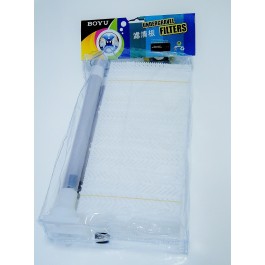Filtration

Internal Filtration
Internal filters are the main-stay of aquarium filtration, providing a system within the tank with no risk of leaks and a simple set up. Usually consisting of a filter box full of filter media, usually sponge, and a powerhead that pulls water in through an inlet on the bottom. The water is then pulled up through the filter media where any dirt in the water is collected by the filter media and then the clean water is pumped back out into the tank.
The filter media is removed and cleaned as often as required, usually simply by washing it using tap water in the sink (careful to use no chemicals though).
Under-gravel Filtration
Under-gravel filters consist of a base plate and an uplift tube. The base plate is put on the bottom of the aquarium before any gravel has been added. You then cover the plate in over an inch of gravel. The uplift tube is connected to the base plate and a powerhead is placed on top of the uplift tube. This causes water to be sucked through the tube, which in turn causes water to be sucked through the base plate. As this water is being sucked through the gravel into the base plate any dirt in the water is dragged down into the gravel.
To clean this filtration system you require a gravel cleaning syphon, which you then use to syphon through the gravel dragging all of the dirt out into a bucket without sucking out any of the gravel.


External Filtration
External filters are sealed canisters which sit outside of the aquarium and are composed of an inlet tube and an outlet tube that are submerged in the tank. The water is pulled into the filter where it undergoes a more rigorous cleaning system than a traditional internal filtration system.
These large external filters are usually recommended for larger tanks with a lot of biological matter inside.
 Coldwater, Tropical & Cichlids
Coldwater, Tropical & Cichlids
 Pythons, Boas & Colubrids
Pythons, Boas & Colubrids
 Agamas, Iguanas, Geckos & More!
Agamas, Iguanas, Geckos & More!
 Tortoises & Turtles
Tortoises & Turtles
 Frogs, Toads & Newts
Frogs, Toads & Newts
 Spiders
Spiders
 Hedgehogs, Mantids & More!
Hedgehogs, Mantids & More!
Monday - Saturday: 10am - 5:30pm
Sunday: 10am - 4pm
(Hymenopus coronatus)
(Pantherophis guttatus)
(Pantherophis guttatus)
(Rhombodera Kirbyi)
(Sphrodomantis gastrica)
(Hierodula membranacea )
(Correlophus ciliatus)
(Brachypelma smithi)